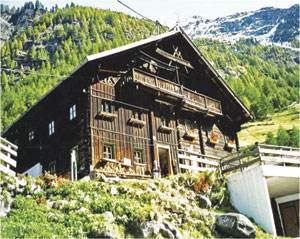BY WILLIAM JANHONEN, LEED AP, NAHB-CGP
The American lexicon now seems comfortable using the term “green building” when describing a commercial or residential building that is more energy-efficient, saves on water consumption, reduces waste, uses fewer resources and is healthier for occupants. We tend to think of green building as something new that is catching on.
 If we look at the history of building in the U.S., we first see windowless pioneer cabins made of logs with mud-filled cracks and bark roofs. Everyone lived in one room with a dirt floor, where vermin and bugs were commonplace.
If we look at the history of building in the U.S., we first see windowless pioneer cabins made of logs with mud-filled cracks and bark roofs. Everyone lived in one room with a dirt floor, where vermin and bugs were commonplace.
As time progressed, so did technology. Slowly, windows, foundations, laid stone chimneys and wood shingle roofs replaced the more inefficient designs.
From 1918 to 1940, the Sears Company offered complete homes through a catalog. You could purchase an entire house, delivered by railcar to your town. The local railman would inform you that the 30,000 pieces of your home had arrived with a 12-inch leather-bound direction manual. In the mid-1930s, saving oil (for the war effort) became a priority and as a result, new technology to insulate homes became a focus.
We marvel at today’s technology; from foam insulation, fiberglass-covered drywall, triple-paned low E-argon gas-filled windows, composite roofs, tankless water heaters, in-floor radiant heating, photovoltaic electricity, solar thermal heating panels and a myriad of other new products available to make our buildings more “green.” Yet, when I look at the list of technological improvements, I think about a picture I always show when I teach my building science classes of a 700-year-old home in Austria that was built in an area that gets over 40 inches of rain and over 100 inches of snow annually.
 There in front sits Aunt Mimi. The thought that comes to mind is, “What component of building technology allows a home to last 700 years in such a harsh climate? Or is it methodology, how the building was put together, that makes all the difference?”
There in front sits Aunt Mimi. The thought that comes to mind is, “What component of building technology allows a home to last 700 years in such a harsh climate? Or is it methodology, how the building was put together, that makes all the difference?”
One of the greatest obstacles we have today in building more efficient homes is the change in expectations. I grew up in a house with three brothers, one sister, Mom and Dad and one bathroom. Our heating system was a coal furnace, and in the winter there were rooms we “just didn’t go into” until spring. Our expectations conformed to our surroundings. We have gone from families of 3.7 individuals living in houses under 1,000 square feet in 1950, to families of 2.6 individuals living in 2,200 square feet. Our families got smaller and our houses got bigger – so did our expectations. We expect to be cool in summer and warm in winter in every room.
So what about the debate between technology and methodology, which is more important? We as a country have not fully embraced the building science behind the methodology necessary to use critical thinking to create long-lasting, sustainable homes and buildings. Europe’s apprentice system had never been duplicated in this country, and our economic mantra has traditionally been one of guaranteed obsolescence. We take advantage of the resources provided to us and haven’t really been subject to the deprivations of many in other countries. We don’t have the same expectations in our lives that many do in Europe, Asia, Africa and India. Currently gas prices are over $4.00 per gallon in some areas, and people have to make hard transportation decisions. Across the ocean, gasoline is the equivalent of $9.00 per gallon in France and $11.00 per gallon in Ireland. They say that necessity is the mother of invention – when will the necessity become reality for building green? Most likely when the incentive for green building increases and everyone can see the benefits. A 2008 McGraw-Hill study showed 330,000 homes were built with eco-friendly features. That is 6.2 percent of new homes, compared to 1.8 percent in 2005. “Going green” was not limited to high-end home buyers. More than 50 percent of buyers choosing green earned less than $75,000 a year, and 30 percent earned less than $50,000. According to the National Association of Realtors, it was estimated that the average green home buyer is willing to spend $12,400 extra.
The answer to the technology vs. methodology debate is: both are equally important. What is most important is critical thinking about integrating both technology and methods to derive a holistic approach in creating solutions. The methods we use to build sustainable homes can only be enhanced and supported by new technology. If we give each of the areas equal attention and analyze the best method appropriate to solve each problem, we will reap the available incentives.
I recently did a site survey for an individual who owns a home built in 1992. The 2,800-square-foot house has both photovoltaic and solar thermal panels on the south-facing roof lines. The owner wants to add a wind turbine to capture electricity so he can charge his prospective electric car and add to his “grid tied” energy sold to the local power provider. As it stands today, he only pays energy bills six months out of the year. By adopting new technology using well-thought-out methods in to his existing home, he has become not net zero, but is closing in on it and couldn’t be happier with his choices.
William Janhonen teaches green building at several colleges and universities in the Northeast.
Photos courtesy of William Janhonen






